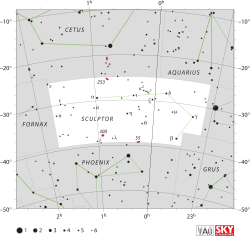Sculptor (constellation)
| Constellation | |

|
|
| Abbreviation | Scl |
|---|---|
| Genitive | Sculptoris |
| Pronunciation |
/ˈskʌlptər/, genitive /skəlpˈtɒrᵻs/ |
| Symbolism | the Sculptor |
| Right ascension | 0 |
| Declination | −30 |
| Family | La Caille |
| Quadrant | SQ1 |
| Area | 475 sq. deg. (36th) |
| Main stars | 4 |
|
Bayer/Flamsteed stars |
18 |
| Stars with planets | 6 |
| Stars brighter than 3.00m | 0 |
| Stars within 10.00 pc (32.62 ly) | 2 |
| Brightest star | α Scl (4.30m) |
| Nearest star |
Gliese 1 (14.22 ly, 4.36 pc) |
| Messier objects | 0 |
| Bordering constellations |
Cetus Aquarius Piscis Austrinus Grus Phoenix Fornax |
|
Visible at latitudes between +50° and −90°. Best visible at 21:00 (9 p.m.) during the month of November. |
|
Sculptor is a small and faint constellation in the southern sky. It represents a sculptor. It was introduced by Nicolas Louis de Lacaille in the 18th century. He originally named it Apparatus Sculptoris (the sculptor's studio), but the name was later shortened.
The region to the south of Cetus and Aquarius had been named by Aratus in 270 BCE as The Waters – an area of scattered faint stars with two brighter stars standing out. Professor of astronomy Bradley Schaefer has proposed that these stars were most likely Alpha and Delta Sculptoris.
The French astronomer Nicolas-Louis de Lacaille first described the constellation in French as l'Atelier du Sculpteur (the sculptor's studio) in 1751–52, depicting a three-legged table with a carved head on it, and an artist's mallet and two chisels on a block of marble alongside it. De Lacaille had observed and catalogued almost 10,000 southern stars during a two-year stay at the Cape of Good Hope, devising fourteen new constellations in uncharted regions of the Southern Celestial Hemisphere not visible from Europe. He named all but one in honour of instruments that symbolised the Age of Enlightenment.
Sculptor is a small constellation bordered by Aquarius and Cetus to the north, Fornax to the east, Phoenix to the south, Grus to the southwest, and Piscis Austrinus to the west. The bright star Fomalhaut is nearby. The three-letter abbreviation for the constellation, as adopted by the International Astronomical Union in 1922, is 'Scl'. The official constellation boundaries, as set by Eugène Delporte in 1930, are defined by a polygon of 6 segments. In the equatorial coordinate system, the right ascension coordinates of these borders lie between 23h 06.4m and 01h 45.5m, while the declination coordinates are between −24.80° and −39.37°. The whole constellation is visible to observers south of latitude 50°N.
...
Wikipedia
